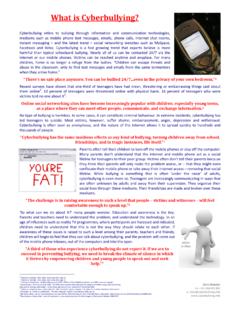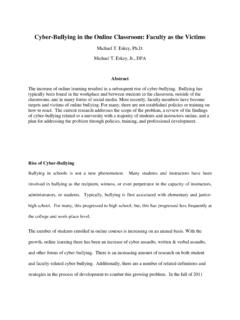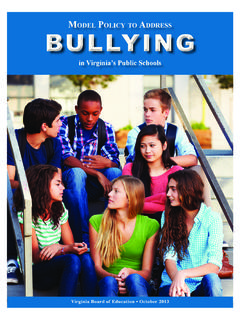Transcription of Cyber-Bullying: Freedom of Expression vs. …
1 Reilly 1 cyber - bullying : Freedom of Expression vs. Freedom from Harassment Brendan Reilly Introduction The First Amendment of the Constitution guarantees Freedom of Expression . Freedom of Expression has long been thought an essential Freedom and the cornerstone of a free and democratic society. However, the Supreme Court has scaled back constitutional protections in certain situations. For instance, the Court has said students have a lesser expectation of certain constitutional guarantees when on school Along those same lines, the Court has held that schools may regulate student Expression if the Expression is part of a school-sponsored activity, if the Expression is lewd or vulgar, or if the Expression substantially disrupts school operations and invades the rights of Recently, there has been an increasing trend of cyber - bullying . cyber - bullying entails the harassment of students using social media websites, text messages, emails, and other technology. cyber - bullying presents several new and troubling problems for state government, the school systems, parents, and the courts.
2 Most importantly, cyber - bullying can lead to dire consequences, such as grief-induced suicides. Sadly, this occurs frequently because cyber - bullying is often aimed at emotionally fragile adolescents. Clearly, such tragic consequences should be prevented. As the paper will discuss, the burden to prevent such tragedy should not fall squarely on schools. First, schools have limited authority to regulate or punish student Expression that occurs outside of school. However, schools often become aware of harmful behavior first. When this is the case, they should intervene in an appropriate manner when 1 New Jersey v. 469 325, 348 (1985) 2 See discussion of Tinker, Bethel, and Hazelwood supra Reilly 2 intervention is required. Second, online harassment rarely reaches a level of criminality. Therefore, states or the federal government should pass legislation that gives law enforcement agencies the power to punish offenders in certain extreme cases.
3 Finally, parents need to supervise their children and their online activities. Parents are the first, and most effective, line of protection against online harassment. In sum, the prevention of cyber - bullying and the attendant tragedies requires the cooperation of parents, government, and school districts. First Amendment Jurisprudence In Tinker v. Des Moines Indep. Cmty. Sch. Dist., students decided to voice their opposition to the war in Vietnam by wearing black armbands to Administrators in the Des Moines School District learned of this plan and preemptively adopted a policy prohibiting such Students who wore the armbands to school were sent home and suspended from school until they decided to return to school without the The students brought suit against the administrators, and the Supreme Court eventually held the First Amendment protected such passive The majority reasoned that students do not shed their constitutional rights to Freedom of speech or Expression at the schoolhouse gate.
4 7 The Court further elaborated, Free speech is not a right that is given only to be so circumscribed that it exists in principle but not in fact. 8 This seminal decision set forth a two-pronged test to determine whether the First Amendment protects a student s Expression . A student may express himself so long as he does so without 3 Tinker v. Des Moines Indep. Sch. Dist., 393 503, 504 (1969) 4 Id. 5 Id. 6 Id. at 513 7 Id. at 506 8 Id. at 513 Reilly 3 materially or substantially disrupting school operations or invading the rights of The Supreme Court was again confronted with this issue in Bethel Sch. Dist. No. 403 v. Fraser seventeen years later. In Bethel, a student gave a speech to roughly 600 students that was lewd, graphic, and sexually The next day, the assistant principal decided the speech violated one of the school s disciplinary rules and suspended the The Court held the School District acted within its permissible authority by suspending the In reaching this conclusion, the Court reasoned that Freedom of Expression must be balanced against society s countervailing interest in teaching students the boundaries of socially appropriate behavior.
5 13 Viewing the Court s holding in light of Tinker, it appears the Court felt the lewd speech violated the first prong of the Tinker test because it was materially or substantially disruptive. Both decisions were important developments in the law relating to students rights under the First Amendment while on school property. Yet, both decisions were fairly limited and slightly ambiguous. After Tinker and Bethel, two principles were known definitively. First, passive and symbolic (or pure ) Expression was protected under the First Amendment so long as it did not substantially disrupt school operations or collide with the rights of others. Second, the First Amendment did not protect lewd speech at a school assembly because it was disruptive to school operations, and the school had a right to regulate and punish such Expression . 9 Id. 10 Bethel Sch. Dist. No. 403 v. Fraser, 478 675, 678 (1986) 11 Id. 12 Id. at 685 13 Id.
6 At 681 Reilly 4 Two years after Bethel, the Court was faced with an issue that fell somewhere in the gray area between Tinker and Bethel. In Hazelwood Sch. Dist. v. Kuhlmeier, the Court was faced with the question whether school officials may edit the contents of a student newspaper without violating the students rights to Freedom of The students in Hazelwood were staff members of the school newspaper, the In one issue, school officials decided to delete two full pages of the Spectrum, because the articles on those pages detailed students experiences with pregnancy and the effects of Finding no First Amendment violation here, the Court distinguished Hazelwood from Tinker. The Court reasoned this was a different case than Tinker because the question was not whether a school must tolerate certain student speech, but rather, whether a school must promote particular student Educators have more authority to regulate speech in the second scenario, because such school-sponsored activities may be treated as part of the school curriculum when supervised by teachers and designed to teach students skills or particular In reaching this conclusion, the Court articulated a different standard than the one set forth in Tinker.
7 The Court held educators may regulate student speech in school-sponsored activities so long as their actions are reasonably related to legitimate pedagogical concerns. 19 Reading these three cases together, a school may regulate Expression in a school-sponsored expressive activity so long as the regulation is reasonably related to legitimate pedagogical concerns. 20 Lewd speech can be regulated regardless of whether 14 Hazelwood Sch. Dist., 484 260, 262 (1988) 15 Id. 16 Id. at 263 17 Id. at 270-71 18 Id. at 271 19 Id. at 273 20 Id. Reilly 5 the speech is part of a school-sponsored activity and the regulation need not be related to legitimate pedagogical Finally, if the Expression is neither lewd nor part of a school-sponsored activity, it can only be regulated if it substantially disrupts school operations or impairs the rights of However, these questions are exacerbated by the expansion and increasing pervasiveness of technology in our nation s schools.
8 The growing popularity of social media websites such as Facebook, MySpace, and Twitter, and the increased presence of computers in the learning environment, has led to a number of problems. Some students use these sites to harass other students or insult teachers and school administrators. The fundamental question becomes, do schools have the right to regulate student Expression on the Internet? How about student Expression that originates on a home computer, but is accessed at school? Can schools do anything about the increasing problem of cyber - bullying , or does this responsibility fall on parents and the respective states? The next section will address such questions. What Can the Courts Do? Every person that has ever attended middle school or high school knows that there is a level of bullying or harassment accompanied by school attendance. In a modern context, this bullying is exacerbated by technology. Students now harass other students via text message, email, or through the use of certain social media websites.
9 Such harassment is often referred to as cyber - bullying . cyber - bullying is worse than traditional bullying in a number of ways. First, it severely affects an adolescent s already-fragile emotional state. Second, victims of cyber - bullying do not escape the harassment when they leave school; they are often subject to threats and harassment 21 Bethel 478 at 685 22 Tinker 393 at 513 Reilly 6 around the clock. Finally, given the pervasiveness of the Internet, such threats and harassment are often more public than traditional bullying and can be viewed by other students attending the same school. cyber - bullying is a serious problem, but how can schools regulate student activity online without violating the First Amendment? Recently, several courts have been faced with the problem of school regulation of student conduct on the Internet. One such case was Coy v. Bd. of Educ. of the North Canton City Sch. In Coy, a student created a website on his home computer and on his own The website contained mostly biographical information about himself and some of his However, there was a section titled Losers, that contained the pictures of three boys who attended the same school as Under each picture, there were derogatory statements about each When the website was brought to the attention of school officials, the superintendent originally suspended the defendant for four days, and then expelled him for eighty days because he did not approve of the website s Defendant alleged the school administrators violated his rights under the First Amendment by disciplining him for the content of his The court decided to apply Tinker s standard because there was no evidence that defendant brought his website to the attention of other students; therefore, it was a silent, passive Expression of opinion.
10 29 The court refused to grant summary judgment because it reasoned that material issues of fact existed as to the basis for the student s 23 Coy v. Bd. of Educ. of the North Canton City Sch., 205 F. Supp. 2d 791, 795 ( Ohio 2002) 24 Id. 25 Id. 26 Id. 27 Id. at 794 28 Id. at 798 29 Id. at 800 Reilly 7 The school argued it punished the student for accessing an unauthorized website while on school grounds, and the content of the website was only considered for disciplinary purposes because it contained vulgar However, the student presented evidence he was actually disciplined because of the content of the The court ruled a material issue of fact existed as to which explanation was Moreover, the court said if the school did in fact punish the student for the content of his website, then the student would prevail because such punishment would be unconstitutional under the First In another case, a student compiled a list of insults directed at a school official and emailed the list to several of his A fellow student eventually printed off the list and distributed it on school The student who originally created the list was suspended ten days and eventually brought suit alleging that his rights under the First Amendment had been The court ruled in favor of the student and decided the suspension was indeed a violation of the First In reaching this decision, the court reasoned that school officials have less authority in regulating speech that occurs off school grounds, as the speech here However, the court believed Tinker applied because the off-campus speech eventually made its way onto school 30 Id.









